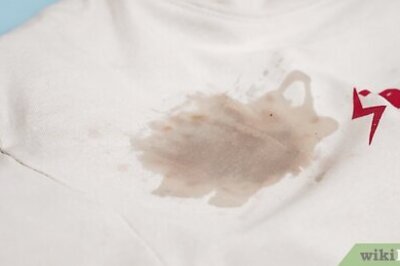
views
The recent violence in Muslim-dominated Nuh in Haryana left several people dead, property worth crores damaged and a deeply scarred local Hindu community. It is unfortunate that a section of media, social media and certain political leaders are trying to peddle false narratives. The violence in Nuh started following a peaceful religious procession of Hindus that was pre-scheduled to go from a certain route. The procession was attacked and soon violence spread. This is an unfortunate and condemnable incident. Many such incidents have happened in the past also. If we want to keep a check on such incidents, one has to understand the anatomy of Hindu-Muslim riots in India.
What we are witnessing today is an evolution of a toolkit of rioting that evolved over a period of at least 100 years. Let us take a look at some of the Hindu-Muslim riots in the past.
Pre-Independence Riots
Mymensingh Riots (1906-1907)
The riots in Mymensingh (now in Bangladesh) started on April 21, 1906, and continued for several months. These riots began when some Swadeshi volunteers tried to stop some Muslim shopkeepers from selling foreign products at a fair in Jamalpur city. The Muslim shopkeepers attacked the volunteers who were primarily Hindus. Soon, communal violence spread to other parts of the district. Sumit Sarkar mentions in ‘The Swadeshi Movement in Bengal 1903-1908’ (pp 459), “Once started, the iconoclasm, of course, gathered a momentum of its own and Muslims started smashing Kalibaris (temples of goddess Kali) and destroying family idols.”
“Attacks were recorded on the huts of washermen, weavers, milkmen, fishermen, carpenters, potters, cobblers and other lower caste Hindus…Both official and non-official records cite instances of attacks on Hindu women. Rioters broke into homes and took away young widows, and women hid themselves in jungles for days to escape assaults. The honour of woman constituted the most sacrosanct feature of Hindu social ideology and violation thereof thus implied the total destruction of a Hindu’s honour,” Das observed (pp 49-50).
Dacca Riots (1926)
The Dacca riots broke out when Muslims objected to an age-old tradition of playing music in a Janmashtami (celebration of the birth of Lord Krishna) procession. They wanted the music to be stopped when the procession was passing in front of any mosque in the city. During the Dacca riots, Muslim crowds specifically targeted Sahas who were the leading traders in the town and Basaks who played an instrumental role in organising the Janmashtami procession. Their houses were attacked in a planned manner. During the Dacca riots too, several Hindu temples and idols were desecrated and Hindus from all strata were targeted.
Dacca Riots (1941)
These riots, which started on March 14, 1941, are also called ‘Holi riots’ as the violence had erupted as a reaction to Holi celebrations at a market of Hindu artisans known as Sankharibazar. The riots lasted till April 29 although sporadic incidents continued till the end of May.
According to Suranjan Das’s ‘Communal Riots in Bengal 1905-1947’, (pp 143), “Violence spread rapidly to the countryside and culminated in general Muslim rising…Altogether 2734 incidents were reported in the city and suburbs, 3000 people were rendered homeless;109 people lost their lives; 2080 in urban and 1690 in rural areas were arrested on various rioting charges.”
Anwesha Roy highlights the significance of these riots in ‘Making Peace, Making Riots: Communalism and Communal Violence, Bengal 1940-1947’, “Almost all cases of loot, arson followed the same pattern. First, Hindu inmates were asked if they would convert to Islam. If they agreed, they were immediately made to go through a formal ceremony of conversion. In some cases, houses of converted Hindus were spared from loot and arson, but they were informed that a common feast would soon be held where they would have to eat beef and marry off ‘their women’ to Muslims.”
The Great Calcutta Killings (1946)
From midnight of August 15 up to August 19, 1946, massive anti-Hindu riots took place in the city of Calcutta. The death toll in these riots was estimated to be between 5,000 to 10,000 and around 15,000 persons were wounded. Some estimates have put the figure of dead at 15,000.
Tathagata Roy observed in ‘The Suppressed Chapter of History’ (Pp 105), “How many people died in the killings? No estimate is available, the reason for which is probably that the killings were started by none other than the officialdom…A large number of bodies had been thrown into the river Hooghly, or in the canals that pass through the city, or were pushed into manholes.”
Roy further added, “As an example of deliberate abuse of state power to cause mass murders, it compares well in intensity, though not in breadth, with the Nazi holocaust and the killing fields of Pol Pot in Cambodia.”
Dr. DC Sinha, Ashok Dasgupta and Ashish Chowdhury have provided a detailed account of these riots in their seminal work ‘1946 The Great Calcutta Killings And Noakhali Genocide’ (pp 104-106), “The arrangements were perfect for the programme of loot, arson, rape and murder and truck-loads of goondas (hooligans) armed with dangerous weapons and incendiary material were rapidly sent to the more distant part to reinforce the local hooligans. Soon the city was ablaze from North to South and from East to West. The telephone wires were jammed with frantic appeals of police aid from Hindus of all sections of the city, but these appeals were disregarded in toto…The Hindus of Calcutta gradually realised that denial of police aid was part of the programme…The situation soon became precarious for the Hindus all over Calcutta. The entire city was at the tender mercies of tens of thousands of armed ruffians mad for loot, rape and murder. Their Fuehrer had declared a Jehad, and thousands of gangsters had been imported to reinforce them. Further, they seemed immune from the action of law, for the police had so far been mostly lookers-on.”
Post-Independence Hindu-Muslim Riots
Jabalpur Riots (1961)
The first major Hindu-Muslim riot after 1947 took place in 1961 in Jabalpur. The communal violence spread to neighbouring areas of Sagar, Damoh and Narsinghpur. Justice Shiv Dayal Shrivastava’s Commission of Inquiry said in its report, “A Hindu unmarried girl, 18-20 years of age, resided with her parents in Jabalpur. On February 3, 1961, at about 1430 hrs, she committed suicide. It is said that two Muslim young men committed rape on her when she was all alone in her house. Immediately after the rape, she poured kerosene oil over her body and set herself on fire. Her shrieks attracted some neighbours, who removed her to Victoria Hospital. The attending doctor asked her how she got the burns. She told him the cause. Her dying declaration was recorded by doctor because, according to police officers, no Magistrate was available. The unfortunate girl died the same evening at about 20.00 hrs. It is said that two Muslim young men were arrested on the night of the 3rd February, 1961 in connection with the alleged rape. On the morning of the 4th February, 1961 about 200 local students took out a procession to condemn the rape incident. They were empty handed; some had bicycles…A part of the procession branched off towards Anjuman Islamia School and wanted its boys to join them in the condolence meeting. They complained of stones having been hurled on them…Military was summoned in aid at about 13.30 hrs. The flag march of the military had a salutary effect and it appeared that all became quiet. But in the meantime, at about 16.30 hrs, a serious riot occurred in Belbagh where two Muslims resorted to firing. Four Hindus were wounded, one of whom died in the hospital the same evening.”
Justice Raghubar Dayal Commission
Justice Raghubar Dayal Commission was appointed by the Central government in November 1967 to enquire into the causes of the occurrence of major communal disturbances at Ranchi-Hatia, Jainpur and Suchetpur, Ahmadnagar, Sholapur, Malegaon and Sursand. According to the National Police Commission’s sixth report that dealt with this issue of handling communal riots also, Justice Raghubar Dayal Commission had recommended: Mosques should be searched by the police close to the time of the passage of the procession to ensure that there is no collection of materials which could be used as weapons of offence. Police officers searching the mosques should make sure that all entrances to the mosques are guarded and searched properly. The policemen who are posted on rooftops should be in uniforms and not in plain clothes. Arrangements should be made for a photographer to monitor processions. There should be proper arrangements for the enforcement of the curfew and other prohibitory orders.
The Hindu-Muslim riots in the pre-independence and the post-independence India have many common traits: Objection by some sections of Muslims to the playing of music in religious processions of Hindus in front of mosques; desecration of Hindu temples and idols during riots; and targeting Hindu women and business establishments. Most of these riots are followed by projecting Hindus as communalists.
The political parties and the intelligentsia seem to feel constrained about the widespread condemnation of Muslim communalists. Nothing could be more ironic that Hindus, who are often at the receiving end during these communal riots, also get accused of majoritarianism at global media and human rights platforms as well as by the Left dominated Indian intelligentsia. Nothing could be farther from the truth if one studies the real anatomy of Hindu-Muslim riots in India.
The writer, an author and columnist has written several books. He tweets @ArunAnandLive. Views expressed in the above piece are personal and solely that of the author. They do not necessarily reflect News18’s views.



















Comments
0 comment